Arts
Novelty of Kandyan dance brings Met audiences to their feet
Performing at the Met was the most prestigious moment for young Sri Lankan dancers Thaji Dias and Sanduni Sulochani and Waruna Sri Hemachandra of the Chitrasena Vajira Dance Foundation. “New York is more like a world hub for dance. To have world famous dancers and choreographers like Mikhail Baryshnikov and Mark Morris in the audience with dance critics was a privilege indeed,” Thaji said adding that Kandyan dance was a novel experience to some in the audience and they were all mesmerized by the leaps and turns, giving the dancers a standing ovation for every performance.
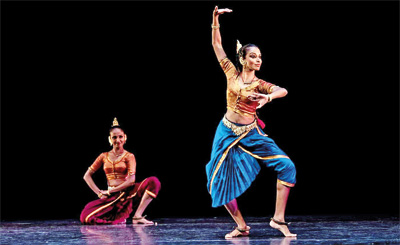
Taking Kandyan dance to the Met: Thaji and Sanduni in performance. Pix by Purpleganesh
It was two perfectly harmonized Eastern dance traditions, carefully curated to bring the utmost essence of the two forms, as the Samhara dance production took the stage at the Metropolitan Museum of Art (the Met) leaving the New York audience awe struck. In fact this was the reception the dancers received for ‘Samhara’ presented by the Nrityagram Dance Ensemble in collaboration with the Chitrasena Dance Company, throughout their tour of the United States.
The Samhara Fall 2018 US Tour took place from September 18 to October 29 with 13 performances in eight venues. Samhara was principally curated and conceptualized by Surupa Sen, acclaimed Odissi dancer, Artistic Director and choreographer at the Nrityagram Dance Ensemble.
Samhara, carrying the meanings of collection and compilation as in a braid woven together, is a cross-cultural collaboration between the Odissi dance tradition from India and Kandyan dance from Sri Lanka.
One of the oldest dance traditions in the world, Odissi was originally a sacred ritual dedicated to the gods. It relates tales of mythology and legend while speaking of love and union between human and divine creating magic and spirituality on stage. Kandyan dance, the ritual-dance tradition of Sri Lanka was originally performed by dancers from a specific caste and aligned to the Temple of the Tooth.
‘Samhara’ has previously toured India, USA and Singapore, 2017 to London, the two dance companies the Nrityagram Dance Ensemble and Chitrasena Dance Company sharing a long friendship, knowledge and passion for dance. “We performed two collaborative pieces, Kandyan and Odissi while the other two were pure Odissi from a total of four performances. The first collaboration was an invocation celebrating the five elements of Earth, Water, Fire, Air and Ether while the later was an Alap, Kandyan and Odissi rhythmical dialogue on stage,” explains Thaji Dias, the principal dancer of the Chitrasena Dance Foundation.
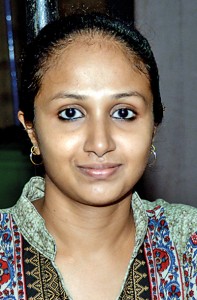
Sanduni Sulochani
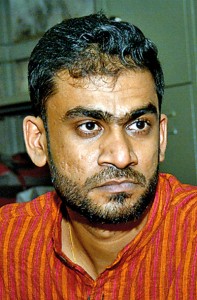
Waruna Sri Hemachandra. Pix by M.D. Nissanka
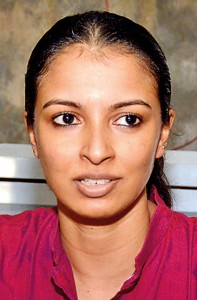
Thaji Dias
“It was on Surupa’s invitation to try something together, that the whole concept of Samhara emerged,” said Heshma Wignaraja, Assistant Choreographer for Samhara who assisted in creating the Kandyan Dance sections.
The dance team performed in Durham – North Carolina, Santa Fe- New Mexico, Seattle- Washington, Derry-New Hampshire, Amherst- Massachusetts, Lewisburg- Pennsylvania and New York. They also held workshops and masterclasses on Odissi and Kandyan dance.
Surupa Sen, Bijayini Satpathy, Pavithra Reddy, Akshiti Roychowdhury, Urmila Mallick and Prithvi Nayak were the Nrityagram dancers while Thaji and Sandani were the Kandyan dancers. Jateen Sahu was the lead vocalist and on the harmonium, Rohan Dahle on Mardala- percussion, Parshuram Das on bamboo flute and Waruna Sri Hemachandra on Geta Bera were the musicians for the tour.
Excelling in Kandyan dancing ever since she joined the Chitrasena Dance Foundation, Sandani has toured with the dance company several times, but Samhara in 2017 was her first encounter with the Indian Odissi dancers. “We performed in different stages and theatres and learned to make stage formations accordingly,” Sandani said.

Sanduni, Waruna and Thaji at the Met
Waruna being the only Sri Lankan traditional drummer in the production fondly recalled his visit to Nrityagram (dance village) in Bangalore for rehearsals. Nrityagram is a creative space where dancers, musicians and choreographers live together, sharing their knowledge for the development of art. “The village is very much attuned to nature and creates a perfect set up to learn art. They eat fresh food cooked from the vegetables and fruits cultivated within the village,” Waruna says while Heshma adds, “At Nrityagram, they eat, breathe, sleep and dance.”
“Through Samhara, I learned a lot about music. More on how to collaborate the sound of Geta Bera with Hindustani music and rhythms,” Waruna further notes. As agreed by Thaji and Sandani, it was a whole new experience for them to perform Kandyan dance with music which gives a different flavour to the overall performance and a different feel for them as dancers.
Late Pandit Raghunath Panigrahi composed the music while Dhaneshwar Swain and Prasanna Rupatilaka were rhythm composers, respectively for Odissi and Kandyan in Samhara.
As Thaji says it is important for a dancer to keep the body always prepared. She recalls moments of the tour where they did stretching and warm-ups inside the hotel rooms. “We didn’t have much time to walk around during the rehearsals. Even when we went out we were extra careful not to meet with any accidents as the show was our main concern,” Thaji laughs.
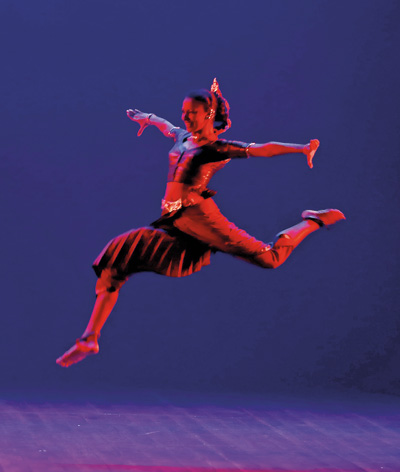
Great leaps: Thaji wows the audience
Heshma was grateful to the Technical Director of the Nrityagram Dance Ensemble, Lynne Fernandez, for her remarkable technical supervision before every show.

